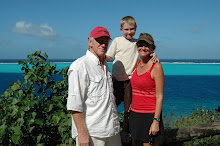 | |
| Bear with Sewa and friends |
For the last few days we’ve been anchored off Ono Island in view of the village of Nagara (pronounced nan-gara). Here we have met the loveliest, most welcome people since coming to Fiji, which is why we’ve lingered here so long. From the moment we pulled our dinghy ashore and were greeted with smiling faces, we knew this was a special place.
As is the custom, all visitors to a Fijian island must pay proper respect to the local villagers before exploring their land or waters. In a ceremony called sevusevu, visitors bring a gift of kava, a native root that is ground to a pulp then made into a tea, to the village chief. He blesses the gift and the visitors are then welcome as family members. We are now invited to explore the village, hike, fish, swim and dive with the encouragement of all the villagers.
We’ve performed this ritual over a half a dozen times now, with varying levels of response. In the Mamanucas where there are many resorts that organize village visits, the Fijian people are very accustomed to white people gawking at them and many seem bored with the process. Even in the Yasawas, we were not a novelty. But down here, in the southern end of Viti Levu in the islands near the Austrolabe Reef, tourism exists on a much smaller scale, and cruising yachts are more rare. In fact, in Nagara there were no visiting yachts for the past two years. So when we arrived along with five other sailboats and filled up their bay, excitement filled the air!
 |
| Fiji men perform the meke |
Our first evening in Nagara we were invited to a meke in the village. We are not quite sure of the translation of meke, but it involves traditional dancing. Kids in schools have performed mekes for us and that evening six young men of the village performed for us. Essentially, it is an interpretative dance performed sitting on the floor dressed in native costumes made from local foliage and pounding the rhythm on the ground with their hands. In the school the following day, the boys brought Bear into the meke line and taught him the moves. He was told that pounding on the floor means falling and upturned hands means catching. An arm in the air was a sword and other warrior moves involved slashing arms and chop-saw strokes. The dances are very entertaining and the accompanying music is upbeat and provocative. The entire room sways and claps to the beat as all are entranced by the dance moves.
 | |
| Sitting around the kava bowl |
Prior to and following the meke is the traditional drinking of kava. Once solely a male ritual, women now participate as well. Kava is a mild drug, similar to marijuana, that is legally grown in many South Pacific islands and is used for recreational purposes. The root of the kava plant is pounded into a powder which is mixed with water and strained through a cloth to produce a tea-like mixture. It is served in a wooden bowl on the floor surrounded by the men who are preparing the mixture . During the evening the men takes turns pounding the root, ringing it through the cloth bag, and serving the grog (another name for kava). The affects of kava vary. The initial reaction is a numbness of tongue and lips. Beyond that, it is a matter of tolerance, quantity and strength of the root. At best, you become very mellow. At its worse, your body becomes numb as if you are drunk.
Along with kava during the meke, the women served us tea and sweets. The tea was very simple – hot water with a leaf from a lime tree. It was surprisingly flavorful and good. The sweets were unique and tasty, although not as sweet as an American dessert would be. These were made from coconut, kasava root or taro root mixed with some sugar and flour and baked, with a thin layer of sugar icing on top. Again, they were surprisingly good and, together with the tea, it was a nice treat.
After a few hours of singing, refreshments, kava and talking, the elder called an end to the evening and they sang us the traditional Fijian good-bye song. Before we left, the entertainment for the following evening was arranged – dancing for all of us at Bar 66. We had no idea what that was all about....

